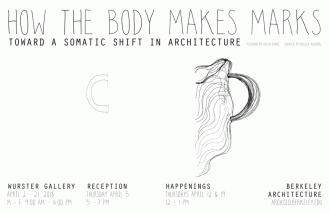We experience architecture with our whole bodies, not just our eyes. However, contemporary architecture is commonly and increasingly designed for visual impact and without regard for the rest of the body. How the Body Makes Marks, an exhibition curated by Chelsea Rushton in Wurster Gallery (121 Wurster Hall, on view April 2-21), features the results of ongoing research by Architecture Professor Galen Cranz on the effects of somatic experience on drawing and the potential implications of somatic drawing on architecture and design.
Chelsea and Galen met at the 2015 conference of the Architecture, Culture, and Spirituality Forum, where Chelsea presented MFA research (University of Calgary, 2015) on art’s ability to imbue a quotidian gallery space with spiritual qualities and Galen discussed the role of architecture in facilitating spiritual practice and experience in the body. Galen offered Chelsea a copy of her recently published paper, “Design and Somatic Experience: Preliminary Findings Regarding Drawing Through Experiential Anatomy” (Cranz and Chiesi, Journal of Architectural and Planning Research, Winter 2014). This paper hypothesizes that deliberately priming the different layers of the triune brain through somatic exercises can can affect the size, shape, and dimensionality of subsequently produced drawings.
Chelsea responded enthusiastically to the research, not only because the effects of somatic experiences were evident in her own drawings to date, but also because she could see the potential of somatic drawing on the designs of our built environments. In 2016, CED Dean Jennifer Wolch accepted Chelsea’s proposal for How the Body Makes Marks, scheduled to coincide with Galen’s final semester of teaching after 43 years at UC Berkeley. Chelsea is here at Cal this semester as a Visiting Scholar in the Architecture Department to curate, design, and program the exhibition.
How the Body Makes Marks selects drawings from the collection Galen has gathered since 2008 from the students in her annual Body Conscious Design seminar who participate in this research. Each participant makes two pairs of drawings, either of handles and lamps, or of buildings and urban plazas—elements of the built environment at different scales with which we commonly interact. Participants produce the first drawings after stimulating the neocortex with math problems; they create the second drawings after stimulating the brainstem and limbic system with exercises that focus awareness on body organs. Selected drawings are exhibited for their visual interest and humour, and especially for the often surprising differences between two drawings in a pair.
The exhibition first presents handles and lamps: architectural elements that we hold in, grasp with, and operate by our hands; then, it shows buildings and urban plazas: architectural environments that hold and contain us. Finally, visitors are invited to contribute their own somatic drawings to the exhibition’s imagination of what can change in the built environment, and in us, when we design with and for the whole body.
How the Body Makes Marks shows in Wurster Gallery (121 Wurster Hall) from April 2 - 21, 2018, Monday - Friday, 9 am - 4 pm. The exhibition is free and open to the public. The Berkeley community and the public is invited to the opening reception, with remarks by Galen Cranz and Chelsea Rushton, on Thursday April 5, 5 - 7 pm, and to the live somatic drawing sessions that will take place in the gallery on Thursdays April 12 and 19 from 12 - 1 pm.
Upon completion, Chelsea will present documentation of How the Body Makes Marks both in a print catalogue and in a combined paper presentation and workshop at the 13th International Dabrowski Congress in Chicagoland (July 12 - 14, 2018).
Dr. Galen Cranz is a sociologist, designer, and certified teacher of the Alexander Technique (a system of body-mind postural education). She studies the social-cultural components of environmental design, including how the body meets the environment, a new subject she has called Body Conscious Design. She also studies post-occupancy effects of designs on users, the role of urban parks, and taste as a communication process in design.
Curator Chelsea Rushton holds an MFA in Visual Art from the University of Calgary and is certified at the 500 hour level as a yoga teacher. Her creative research focuses on the intersections of art, ritual, spirituality, and somatics, and the ways in which creative process can document and facilitate personal and collective growth and evolution. She is the developer and instructor of Art of the Soul: Creative Process as Spiritual Practice, a special topics lecture, seminar, and studio course that profiles 20th century modern and contemporary artists who engage in art-making as a method of spiritual inquiry and practice.
